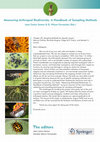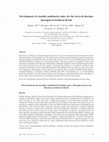Papers by Riccardo Mugnai

Sincerely yours, We trust all of you are well, safe and healthy in these unprecedented times. We ... more Sincerely yours, We trust all of you are well, safe and healthy in these unprecedented times. We are very happy to contact you to let you know that our project is now coming to completion. With more than 1.2 million described species, the Arthropoda represent the most speciose group of animals on Earth, with a remarkable number of species still undescribed. These invertebrates are recognized as playing important ecological roles in terrestrial, marine, and freshwater ecosystems, also through their impact on humans, by causing crop damage or acting as vectors for disease transmission. Some of them are also excellent indicators of ecosystem integrity and are extremely important in environmental assessment studies. Otherwise, they are being thretened by the ongoing climatic crises with effects we still do not know enough. Hence, the book we were able to build is of great relevance because the use of specic sampling methods and techniques is crucial to understand their biodiversity, dy...
Crustaceana, 2020
The preparation of specimens is a crucial aspect of zoological studies. Some specific study techn... more The preparation of specimens is a crucial aspect of zoological studies. Some specific study techniques or certain taxonomic groups require staining processes. However, an excessive exposure to the staining agents can turn a specimen improper for morphological studies. Here, we report that an excess of chlorazol black, one of the most used stains in biology, can be easily removed from crustacean specimens with a solution of methanol and Extran ® detergent or, less effectively, with a solution of methanol and commercial dishwashing soap.
Comparative Parasitology
abstract: In northeastern Brazil, studies related to freshwater fish macroparasites are incipient... more abstract: In northeastern Brazil, studies related to freshwater fish macroparasites are incipient. This paper presents 2 new records for cymothoid isopods plus a territory extension for a third species, all in Maranhão State, Northeast Brazil.

European Journal of Taxonomy
The genus Disparalona Fryer, 1968 comprises a well-defined species complex, the hamata-group, whi... more The genus Disparalona Fryer, 1968 comprises a well-defined species complex, the hamata-group, which might have sibling species in South America. This hamata-group needs urgent revision. Besides that, a complete morphological evaluation of the endemic species D. leptorhyncha (Daday, 1905) is lacking. Thus, the aim of the present study is to revise populations of species of the hamata-group in South America and to redescribe D. leptorhyncha. Our findings pointed to an occurrence of species which are part of the Disparalona (Mixopleuroxus) linage. Currently, the Neotropics have the highest diversity to the genus, with three species of the hamata-complex – D. (M.) hamata (Birge, 1879), D. (M.) lucianae sp. nov., D. (M.) tenuispina sp. nov. – in addition to D. (M.) leptorhyncha. These species can be differentiated from each other by the morphology of their rostrum, labrum, and postabdomen.

Biota Neotropica
Multimetric Indices (MMIs) have been widely applied for ecological assessment in freshwater ecosy... more Multimetric Indices (MMIs) have been widely applied for ecological assessment in freshwater ecosystems. Most MMIs face difficulties when scaling up from small spatial scales because larger scales usually encompass great environmental variability. Covariance of anthropogenic pressures with natural environmental gradients can be a confounding factor in assessing biologic responses to anthropogenic pressures. This study presents the development and validation of a predictive multimetric index to assess the ecological condition of Atlantic Forest wadeable streams using benthic macroinvertebrates. To do so, we sampled 158 sites for the index development. We adjusted each biological metric to natural variation through multiple regression analyses (stepwise-forward) and considered that the residual distribution describes the metric variation in the absence of natural environmental influence. For metric selection we considered normal distribution, variation explained by the models, redundancy between metrics and sensitivity to differentiate reference from impaired sites. We selected five metrics to the final index: total richness, %MOLD, %Coleoptera, EPT richness and Chironomidae abundance. The residuals were transformed into probabilities and the final index was obtained through the mean of these probabilities. This index performed well in discriminating the impairment gradient and it showed a high correlation (r = 0.85, p <0.001) with a specific index developed for a particular basin indicating a similar sensitivity. This index can be used to assess wadeable streams ecological condition in Atlantic Forest biome, so we believe that this type of approach represents an important step towards the application of biomonitoring tools in Brazil.

The study, conducted during 2007-2010, aimed to develop and evaluate teaching resources for teach... more The study, conducted during 2007-2010, aimed to develop and evaluate teaching resources for teaching activities for training human resources in the area of water biomonitoring for students of undergraduate courses in biology. The specific goals were trhree: elaborate, develop and valued a technical book specific to the Brazilian reality, consisting of an identification handbook of aquatic macroinvertebrates of Rio de Janeiro State based on the study of existing educational material used in other country; develop an invertebrates conservation system and realize a specific didactic collection, based on the study on conservation techniques and specific problems regarding the use of the collection in classroom. The theoretical empirical research is justified by the absence of specific teaching materials for the area of biomonitoring in Brazil and the scarce literature on evaluation of this kind of teaching resources. To develop the handbook, we use the didactic transposition to mediate the different cultural contexts. To evaluate the handbook we have used jointly the qualitative and quantitative methods. From the standpoint of the users we seek to understand the difficulties, demands and wishes of all possible actors. For quantitative analysis we utilize the Content Analysis. For quantitative analysis we use the Student t test and the analysis of variance (ANOVA). The data were considered significant at p-value less than 0.05. The evaluation process was conducted with biology students, researchers, and teacher. The results showed: a high degree of user´s satisfaction, the handbook is adequate for users needs and desires, the improvements to be provided, and indicated that the material is suitable for future training programs being implemented in Brazil.

Zootaxa, 2015
The range of geographical distribution of Anthalona acuta Van Damme, Sinev & Dumont 2011 and Anth... more The range of geographical distribution of Anthalona acuta Van Damme, Sinev & Dumont 2011 and Anthalona brandorffi (Sinev & Hollwedel, 2002) in Brazil has increased by almost 2000 km to the south. New records of Anthalona verrucosa verrucosa (Sars, 1901) were also added. Populations of Anthalona brandorffi from Central Brazil showed a peculiar morphological variation, with some individuals having only a single denticle on the labral keel. A new species of the simplexbranch, Anthalona neotropica sp. nov., was described based on Brazilian material, and this is the first taxon of this branch registered in the Neotropics. It differs from Anthalona simplex Van Damme, Sinev & Dumont 2011, a Central African species, in the morphology of underneath sack of the lateral head pores, length of IDL setae and armature of first flamingtorch seta of limb IV. It could be distinguished from Anthalona sanoamuangae Sinev & Kotov, 2012 (distributed through the SouthEast Asia) by the morphology of the main head pores, length of IDL setae and armature of the pecten of postabdominal claw. Anthalona neotropica sp. nov. seems to have a benthic/hyporheic habit. All studied species have a wide geographical distribution and could be confused with Anthalona verrucosa Sars, 1901, thus at least some if not all previous records of this species on the continent must be revised.
Oecologia Brasiliensis, 2008
Saude Ambiente Em Revista, Jan 21, 2009

Tropical Zoology
This paper presents the index Índice Biótico Estendido-Instituto Oswaldo Cruz (IBE-IOC) adapted f... more This paper presents the index Índice Biótico Estendido-Instituto Oswaldo Cruz (IBE-IOC) adapted from the Indice Biotico Esteso (IBE) for the Serra do Mar region, Rio de Janeiro State, Brazil. This index was adjusted to 1st to 4th order streams using data from previous studies from 1999 through 2002. The surveys were carried out at 36 sampling sites, most with records from three different times of the year, for a total of 98 sampling events. The adaptation of the index was carried out in three stages: (1) adequacy of the taxonomic list of the SU definition table; (2) vertical modification of the calculation table, considering the taxa richness data; (3) horizontal modification of the calculation table, considering the tolerance of taxa to stress-related factors. In this article, there is also a table with the relative tolerances of the taxa present in the study area. Preliminary tests indicate good sensitivity of the IBE-IOC for the detection of different types of environmental impact, associated with the organic pollution, deforestation and industrial activities.
Pan-American Journal of Aquatic Sciences
Temporarily installed mini-piezometers become unusable with time due to the accumulation of inert... more Temporarily installed mini-piezometers become unusable with time due to the accumulation of inert material inside the tube or during the installation process. This paper aims at presenting a technique for unclogging minipiezometers.
The study of specimens in ecological freshwater studies needs the preparation of a large number o... more The study of specimens in ecological freshwater studies needs the preparation of a large number of microscope slides, with effort of economic resources and space for storage. A modification in the mounting technique and storing for insect larvae and microcrustaceans is presented.
Journal of Insect Science
The authors receive Thomas Edison Award-2014 in Entomology for Inspiration and Knowledge Distribu... more The authors receive Thomas Edison Award-2014 in Entomology for Inspiration and Knowledge Distribution among young research scholars.

Brazilian Journal of Biology
The hyporheic zone (HZ), as the connecting ecotone between surface- and groundwater, is functiona... more The hyporheic zone (HZ), as the connecting ecotone between surface- and groundwater, is functionally part of both fluvial and groundwater ecosystems. Its hydrological, chemical, biological and metabolic features are specific of this zone, not belonging truly neither to surface- nor to groundwater. Exchanges of water, nutrients, and organic matter occur in response to variations in discharge and bed topography and porosity. Dynamic gradients exist at all scales and vary temporally. Across all scales, the functional significance of the HZ relates to its activity and connection with the surface stream. The HZ is a relatively rich environment and almost all invertebrate groups have colonized this habitat. This fauna, so-called hyporheos, is composed of species typical from interstitial environment, and also of benthic epigean and phreatic species. The hyporheic microbiocenose consists in bacteria, archaea, protozoa and fungi. The HZ provides several ecosystem services, playing a pivotal...

Brazilian Journal of Biology
In the Neotropical Region, information concerning hyporheic communities is virtually non-existent... more In the Neotropical Region, information concerning hyporheic communities is virtually non-existent. We carried out a sampling survey in the hyporheic zone of the Tijuca River, in the Tijuca National Park, located in the urban area of the city of Rio de Janeiro. Biological samples from the hyporheic zone were collected in three different stream reaches, in June 2012. The main objectives were: 1) to describe the structure of invertebrate assemblages in the hyporheic zone of a neotropical stream; 2) to apply a reach-scale approach in order to investigate spatial patterns of the hyporheic assemblages in relation to hydrology, depth and microhabitat typology. A total of 1460 individuals were collected and identified in 31 taxa belonging to Nematoda, Annelida, Crustacea, Hydrachnidia and Insecta. The class Insecta dominated the upper layer of the hyporheic zone. Copepods were the most abundant taxon among crustaceans and occurred mostly in the upwelling areas of the reaches. The results of...

PLOS ONE, 2015
The Hyporheic Zone is among the most important interstitial freshwater habitats, but the relation... more The Hyporheic Zone is among the most important interstitial freshwater habitats, but the relationship between biotic and abiotic factors in this zone remains under-explored. Enterobacteria were expected to be present, but no specific studies had ever confirmed this prediction. The aim of this study was, therefore, to evaluate the total coliforms, Escherichia coli and Salmonella spp. in hyporheic water and to determine the relationship of the physical, chemical and environmental factors at different depths in a rainforest stream. To this end, thirty-six water samples were collected at three depths in sites located in the first, second and third orders in diverse substrates. The total coliforms, Escherichia coli and Salmonella sp. were evaluated in terms of their CFU/ml. In the interstitial samples, coliforms were detected in 100% of the samples. The total coliform counts had higher values at intermediate depths, while E. coli and Salmonella spp. instead had higher values at intermediate and large depths, often reaching or exceeding the values of the surface samples. Our results revealed that Salmonella spp. and the coliforms have different microhabitat preferences. Salmonella spp. and coliform species prefer deposition areas, such as lateral sides of pools, curves and bars, but they have a tendency to distribute into different depths, likely due to temperature differences. Salmonella spp. prefer compact substrata, with fewer fluids passing through and with upwelling areas with lower oxygen inflow. The coliform species showed the opposite preference. Our results suggest that bacterial variation is related to environmental factors and physical-chemical parameters within the HZ and may play a key role in the microbial diversity and distribution in these ecosystems.

A zona hiporréica é constituída pelos espaços intersticiais entre as partículas do álveo e é deli... more A zona hiporréica é constituída pelos espaços intersticiais entre as partículas do álveo e é delimitada superiormente pela água superficial e inferiormente pela água subterrânea. A fauna presente, constituída por quase todos os grupos de invertebrados, é denominada hiporreos e ainda é desconhecida nas Américas Central e do Sul. O objetivo desse trabalho é apresentar a fauna e definir os fatores que determinam a distribuição da fauna na zona hiporréica. O material foi coletado em um riacho do Parque Nacional da Tijuca, Rio de Janeiro. A coleta foi realizada utilizando uma bomba tipo Bau-Rouch utilizando minipiezómetros enterrados em diferentes profundidades (-10; -25; -45 cm) e localizados em 4 microhabitats distintos. Cada amostra de 5 litros de tamanho. O material foi preservado em álcool 75% e levado para o laboratório, onde foi realizada uma coloração seletiva com rosa bengala e triagem em lupa. As amostras de água foram analisadas e foram determinados 21 parâmetros físico-químic...

Brazilian Journal of Biology, 2013
Brazil faces a challenge to develop biomonitoring tools to be used in water quality assessment pr... more Brazil faces a challenge to develop biomonitoring tools to be used in water quality assessment programs, but few multimetric indices were developed so far. This study is part of an effort to test and implement programs using benthic macroinvertebrates as bioindicators in Rio de Janeiro State. Our aim was first to test the Multimetric Index for Serra dos Órgãos (SOMI) for a different area - Serra da Bocaina (SB) - in the same ecoregion. We sampled 27 streams of different sizes and altitudes in the SB region. Despite the environmental similarities, results indicated biological differences between reference sites of the two regions. Considering these differences, we decided to develop an index specific for the SB region, the Serra da Bocaina Multimetric Index (MISB). We tested twenty-two metrics for sensitivity to impairment and redundancy, and six metrics were considered valid to integrate the MISB: Family Richness, Trichoptera Richness, % Coleoptera, % Diptera, IBE-IOC index, EPT / C...







Uploads
Papers by Riccardo Mugnai